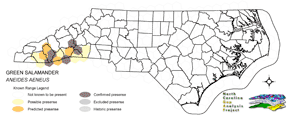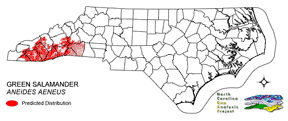
| Taxa: |
| Order: |
| Family: |
| Amphibia |
| Caudata |
| Plethodontidae |
| NatureServe Global Rank: |
| NatureServe State (NC) Rank: |
| G3G4 |
| S2 |
| Federal Status: |
| NC State Status: |
| FSC |
| E |


| Land Unit |
| US Fish & Wildlife Service |
| US Forest Service |
| US National Park Service |
| US Department of Defense |
| NC State Parks |
| NC University System |
| NC Wildlife Res. Com. |
| NC Forest Service |
| NC Div. of Coastal Mgmt. |
| Local Governments |
| Non-Governmental Org. |
| Other Public Lands |
| Private Lands |
| GAP Status 1-2 |
| All Protected Lands |
| Statewide |
| Hectares |
| 0.00 |
| 159,599.34 |
| 0.00 |
| 19,360.44 |
| 2,705.94 |
| 0.00 |
| 8,799.39 |
| 2,206.26 |
| 0.00 |
| 5,039.19 |
| 1,085.58 |
| 0.27 |
| 394,631.28 |
| 44,521.65 |
| 198,353.97 |
| 593,427.69 |
| Acres |
| 0.00 |
| 394,378.48 |
| 0.00 |
| 47,840.68 |
| 6,686.52 |
| 0.00 |
| 21,743.76 |
| 8,295.77 |
| 0.00 |
| 12,452.11 |
| 2,682.53 |
| 0.67 |
| 975,154.94 |
| 112,859.36 |
| 492,987.22 |
| 1,469,235.46 |
| % of Dist. on |
| Prot. Lands |
| 0.0 % |
| 80.5 % |
| 0.0 % |
| 9.8 % |
| 1.4 % |
| 0.0 % |
| 4.4 % |
| 1.1 % |
| 0.0 % |
| 0.3 % |
| 0.3 % |
| < 0.1 % |
| 0.0 % |
| 22.4 % |
| ----- |
| ----- |
| % of Dist. on |
| All Lands |
| 0.0 % |
| 26.9 % |
| 0.0 % |
| 3.3 % |
| 0.5 % |
| 0.0 % |
| 1.5 % |
| 0.4 % |
| 0.0 % |
| 0.8 % |
| 0.2 % |
| < 0.1 % |
| 66.5 % |
| 7.5 % |
| ----- |
| ----- |
|
Populations in North Carolina are considered to be restricted to rock outcrops, and the rocky terrain surrounding them, in mountain counties bordering South Carolina and northeast Georgia (Martof et al. 1980). This salamander dwells in rocky areas, typically in and around cliffs and large rockfaces of sandstone, granite or schist formations, though it has also been found in quartzite and limestone (Petranka 1998). May be limited to outcrops located in hardwood forest (Martof et al. 1980). The salamander shelters in deep moist cracks and crevices of large surface rocks (Petranka 1998), but may also shelter beneath logs or on above ground logs or stumps, presumably near rocky areas (King 1939). NATURE SERVE GLOBAL HABITAT COMMENTS: Damp (but not wet) crevices in shaded rock outcrops and ledges. Also beneath loose bark and in cracks of standing or fallen trees (e.g., in cove hardwoods). Sometimes in or under logs on ground. Sometimes reaches high population densities in logged areas where tree tops are left. Eggs are laid in rock crevices, rotting stumps, or similar dark, damp places. NATURE SERVE STATE HABITAT COMMENTS: See Gordon (1952). |
| Code | Name | Description | NC Natural Heritage Program Equivalent |
| 230 | Piedmont Mesic Forest | American Beech - Red Oak - White Oak Forests. | Mesic Mixed Hardwood |
| 228 | Piedmont Dry-Mesic Oak and Hardwood Forests | Primarily oak dominated forests, white oak is often dominant, with co-dominants including . Also represented by sweetgum and tulip poplar dominated forests. | Dry Mesic Oak Hickory Forest, Basic Oak Hickory Forest, Dry Oak Hickory Forest |
| 382 | Dry Mesic Oak Pine Forests | Mixed forests of the coastal plain and piedmont. Includes loblolly pine with white, southern red and/or post oak and loblolly with water oak. On basic sites of the piedmont, eastern red cedar may co-occur with post, black, and blackjack oaks. | Dry Mesic Oak Hickory Forest, Xeric Hard Pan Forest, Chestnut Oak Forest, Dry Mesic Oak Hickory Forest, Dry Oak Hickory Forest |
| 522 | Northern Hardwoods | High Elevation forests including yellow birch, American beech, and yellow buckeye. Includes forests with Hemlock and Yellow Birch. | Northern Hardwoods Forest, Boulderfield Forest |
| 525 | Appalachian Oak Forest | A variety of oak forest types including Black, White, Scarlet Oaks in dry to mesic situations. Includes forests historically co-dominated by American Chestnut. | High Elevation Red Oak Forest, Montane White Oak Forest |
| 526 | Appalachian Cove Forest | Mixed Mesophytic forests of the mountains. Includes tuliptree, basswood, yellow buckeye and surgar maple. This class is mapped to include cove forests dominated or co-dominated by hemlock. | Rich Cove Forest, Acidic Cove Forest |
| 527 | Appalachian Hemlock | Upland hemlock forests of the moutains region. Vary from side slopes to steep slope positions. | Canada Hemlock Forest |
|
Gordon, R. E. 1967. Aneides aeneus. Cat. Am. Amph. Rep. 30.1-30.2.
Woods, J. E. 1968. The ecology and natural history of Mississippi populations of ANEIDES AENEUS and associated salamanders. Ph.D. dissertation, Univ. Southern Mississippi. Petranka, J. W. 1998. Salamanders of the United States and Canada. Washington DC: Smithsonian Inst. Press. Canterbury, R. A., and T. K. Pauley. 1994. Time of mating and egg deposition of West Virginia populations of the salamander ANEIDES AENEUS. J. Herpetol. 28:431-434. Barbour, R. W. 1971. Amphibians and reptiles of Kentucky. Univ. Press of Kentucky, Lexington. x + 334 pp. Mount, R. H. 1975. The Reptiles and Amphibians of Alabama. Auburn University Agricultural Experiment Station, Auburn, Alabama. vii + 347 pp. Martof, B. S., W. M. Palmer, J. R. Bailey, and J. R. Harrison, III. 1980. Amphibians and reptiles of the Carolinas and Virginia. University of North Carolina Press, Chapel Hill, North Carolina. 264 pp. Green, N. B., and T. K. Pauley. 1987. Amphibians and reptiles in West Virginia. University of Pittsburg Press, Pittsburg, Pennsylvania. xi + 241 pp. Cupp, P. V., Jr. 1991. Aspects of the life history and ecology of the green salamander, ANEIDES AENEUS, in Kentucky. J. Tennessee Acad. Sci. 66:171-174. |
For more information please contact them at:
NC-GAP Analysis Project
Dept. of Zoology, NCSU
Campus Box 7617
Raleigh, NC 27695-7617
(919) 513-2853
www.basic.ncsu.edu/ncgap